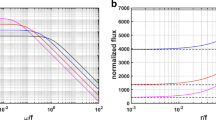Summary
The equations of conservations of momentum and energy scaled with the characteristic values of the mantle indicate the presence of the upper boundary layer to produce the estimated rate of the ocean floor spreading by convection and the importance of the frictional heating. The depth of the upper boundary layer can be estimated from the balance of the viscous force with the horizontal pressure gradient at the sea floor. It is of the orders of 100 km and becomes deeper for the Pacific than for the Atlantic Ocean and also with frictional heating than without it. The frictional heating increases the surface heat flow of the heat conduction by ten to twenty percent for the Pacific Ocean but only by a few percent for the Atlantic Ocean. The similarity solutions are determined for the temperature and horizontal velocity in the upper boundary layer. These solutions are expressed in power series of the variabley x −n, wherex, y, andn are horizontal and vertical coordinates and numerical constant, respectively. Both temperature and horizontal velocity within the boundary layer are higher for the Pacific than for the Atlantic Ocean. When a larger viscosity is applied, it causes the increase of horizontal velocity below the surface because of the surface boundary conditions of the finite velocity and of vanishment of the velocity shear. The higher horizontal velocity generates higher temperature because it advects hotter material from the mid-ocean ridge site. The direct effect of frictional heating on the temperature distribution of the similarity solution is almost negligible, since the shear zone is deep and near the lower boundary of the upper boundary layer. In the similarity solution, the surface heat flow which is increased by the frictional heating is given as the boundary value. The effect of the frictional heating is important below the mid-ocean ridge.
Similar content being viewed by others
References
H. Bénard,Les tourbillons cellulaires dans une nappe liquide, Revue générale des Sciences pures et appliquées11 (1990), 1261–1271, 1309–1328.
K. E. Bullen andR. A. W. Haddon,Derivation of an earth model from free oscillation data, Proc. U. S. Nat. Acad. Sci.58 (1967), 846.
S. Chandrasekhar,Hydrodynamic and Hydromagnetic Stability (Oxford 1961), 652.
R. B. Gordon,Diffusion creep in the earth's mantle, J. Geophys. Res.70 (1965), 2413–2418.
A. L. Hales,Convection currents in the earth, Month. Notices Roy. Astron. Soc. London, Geophys. Suppl.3 (1936), 372–379.
J. R. Heirtzler, G. O. Dickson, E. M. Herron, W. C. Pitman andX. LePichon,Marine magnetic anomalies, geomagnetic field reversals and motions of the ocean floor and continents, J. Geophys. Res.73 (1968), 2119–2136.
C. Herring,Diffusional viscosity of a polycrystalline solid, J. Appl. Phys.21 (1950), 437–445.
T. Ichiye,Marine geological and geophysical research and expedition, inUnderSea Technology, Handbook/Directory 1970 (Compass Publications, Inc., Arlington, Virginia, 1970) A41–A56.
B. Isacks, J. Oliver andL. R. Sykes,Seismology and the new global tectonics, J. Geophys. Res.73 (1968), 5855–99.
L. Knopoff,The convection current hypothesis, Rev. Geophys.2 (1964), 89–120.
W. H. K. Lee andS. Uyeda,Terrestrial Heat Flow, American Geophysical Union, Washington, D. C. (1965), 87–190.
R. K. McConnell,Isostatic adjustment in a layered earth, J. Geophys. Res.70 (1965), 5171–5188.
A. Pellew andR. V. Southwell,On maintained convection motion in a fluid heated from below, Proc. Roy. Soc. London [A],176 (1960), 312–43.
C. L. Perkeris,Thermal convection in the interior of the earth, Month. Notices Roy. Astron. Soc. London, Geophys. Suppl.3 (1975), 343–367.
Lord Rayleigh,On convective currents in a horizontal layer of fluid when the higher temperature is on the under side, Phil. Mag.32 (1916), 529–546.
F. D. Stacey,Physics of the Earth (J. Wiley & Sons, Inc., New York 1969).
D. C. Tozer,Towards a theory of thermal convection in the mantle, inThe Earth's Mantle, edited byT. F. Gaskell (Academic Press, New York), 325–353.
D. L. Turcotte andE. R. Oxburgh,Finite amplitude convective cells and continental drift, J. Fluid Mech.28 (1967), 29–42.
D. L. Turcotte andE. R. Oxburgh,Convection in a mantle with variable physical properties, J. Geophys. Res.74 (6) (1969), 1458–1474.
F. J. Vine andD. H. Mathews,Magnetic anomalies over ocean ridges, Nature,199 (1963), 947.
R. P. Von Herzen andM. G. Langseth,Present status of oceanic heat-flow measurements, in Physics and Chemistry of the Earth, Vol. 6, edited byL. H. Ahrens et al., (Pergamon Press, 1965), 365–407.
Author information
Authors and Affiliations
Rights and permissions
About this article
Cite this article
Ichiye, T. Boundary layer models of ocean floor spreading. PAGEOPH 85, 324–353 (1971). https://doi.org/10.1007/BF00875419
Received:
Issue Date:
DOI: https://doi.org/10.1007/BF00875419



